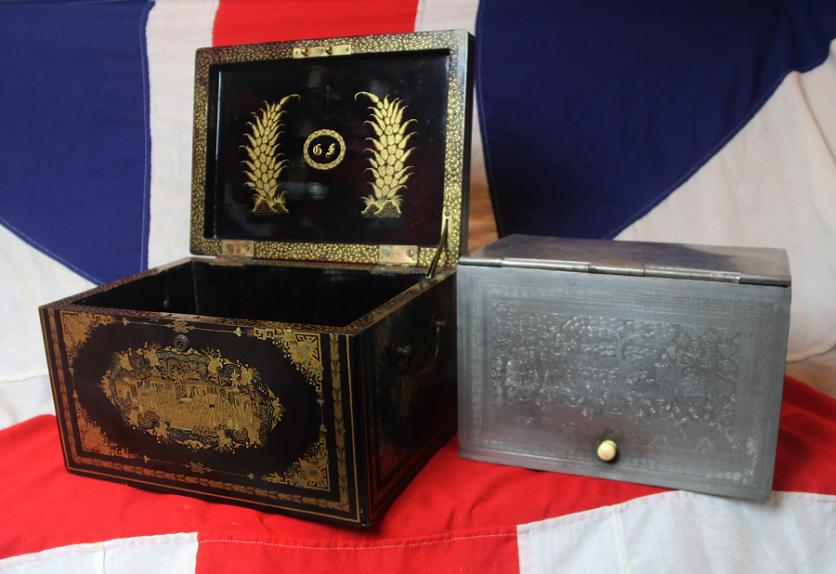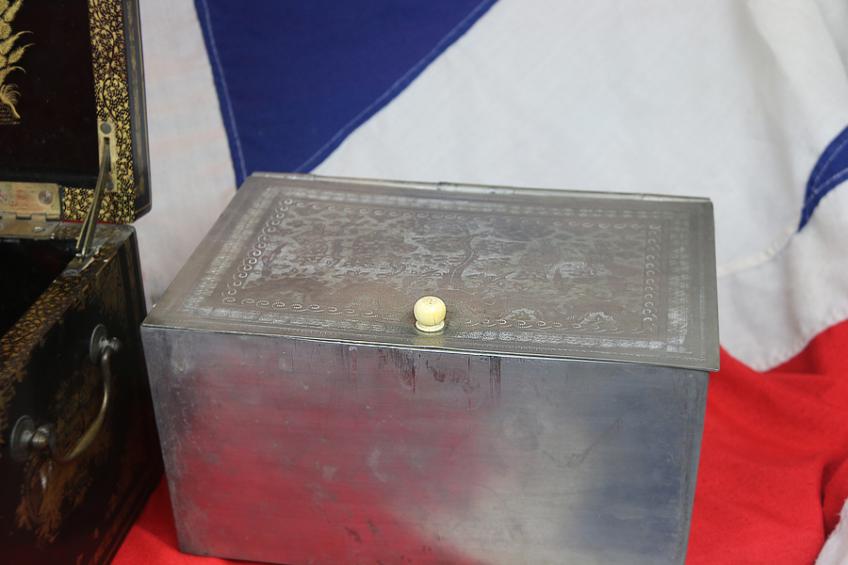A fabulous Chinese Export Chinoisserie Black Lacquer and Gold Large Tea Caddy Chest of the Finest Quality, King George IIIrd, circa 1800's from the Estate of a 23rd Foot, Royal Welsh Fusiliers Peninsular War and Waterloo Officer George Fielding
An antique finest quality Chinese export hand gilded Chinoiserie tea chest caddy with hinged lid, and interior lidded pewter container, for the most precious tea, and made for the European market. Possibly made in Foo Chow.
Not only is the exterior stunningly decorated in the Chinoiserie style, the interior pewter container’s lid is exquisitely engraved to match, with another fabulous and highly elaborate oriental scene of figures and countryside. The lacquer shows scenes of a typical Southern Chinese scholar's garden with people in it, all done in black and gold. Surrounding these scenes are typical Chinese decorative motifs incorporating several auspicious symbols..
This is a superlative tea chest, and note that its exceptional size makes it a most rare type of tea 'chest' size caddy. It is hand crafted with hand painted chinoiserie gilt and ebonized black lacquer. It is painted on all sides with multiple figures, pagoda and palace gardens, with additional geometric and floral designs. It retains its original hand engraved pewter lidded tea casket; It has 2 carrying handles on the sides. It also has most satisfying heft in its weight. The lid’s gilding is worn as to be expected, but all the remaining 4 faces are in excellent near mint condition, as is the interior and the tea casket. The inner lid area contains the monogram of George Fielding, ‘G F’, a British army officer and a Peninsular War and Waterloo veteran, for whom it was commissioned. Captain George Fielding, of the 23rd Regiment of Foot, the Royal Welsh Fusiliers, was a veteran of the Battle of Waterloo who was wounded at the battle, and who resided at Startforth Hall, Startforth, County Durham.
Captain Fielding served in the Peninsular War from Aug 1811 to April 1814, at Aldea de Ponte, Badajoz, Cuidad Rodrigo, Nive, Toulouse, & Orthez. He died in Bath in 1830.
Chinoiserie, so called from 'Chinois' the French for Chinese, was a style inspired by the finest art and design imported from China, Japan and other Asian countries in the 18th century. At its height in Britain from the mid 18th century, this fanciful style relied more on the designer's and craftsman's imagination than on accurately portraying oriental motifs and ornament.
In it earliest days the tea it contained would have been valued by today’s standard thousands of pounds so one can understand why its container should be so fine and a superb work of art in it’s own right. In England in the 1700s, tea was an incredibly expensive commodity. To keep it safe, people would store it in a tea Chest or tea box, which eventually became known as a tea caddy (the word caddy is derived from the Malay "Kati", a unit of weight by which tea was sold). As tea was too expensive to risk leaving in the presence of servants, the caddy in which it was stored would generally be kept in the drawing-room. Subsequently, the tea caddy became an important & fashionable accessory for the home. Tea Caddies were made in a huge variety of styles and materials..
In the manufacture of lacquer-ware the lightest kinds of wood are used. After planing, the surface is covered with a coating of grasscloth fibre and Broussonetia paper, and a mixture of pigs' or buffaloes' gall and pulverised old red sandstone serves as a priming. The article is then placed in a dark room, and a coating of the prepared lacquer laid on with a brush and allowed to dry; and according to the fineness of the ware these coatings are repeated from 3 to 15 times. When the hut coat is dry the articles are painted and gilded. The lacquer, sap of the Vemix vemieiaf used in Canton, is imported from Szechuen or Kiangsi. The gold colouring (a solution of gold leaf in glue water) is laid on with lye of potash ; red is native cinnabar, pink a varnish prepared from Carthamus and green is formed by a mixture of hartall and indigo. Nearly all the lacquer-ware is manufactured in Canton, but magnificent specimens, far exceeding the Canton ware in beauty, colour and fineness are turned out at Foochow. They are made by a single family, said to be of Japanese origin, who brought the secret over with them and have retained it ever since.
From: Catalogue of the Chinese Imperial Maritime Customs Collection
at the United States International Exhibition, Philadelphia, 1876
Inspectorate General of Customs, 1876
13.5 inches x 9.75 inches x 8 inches
Code: 23900
2150.00 GBP








